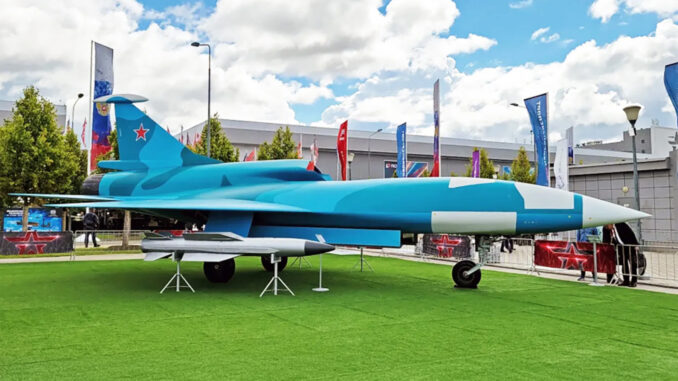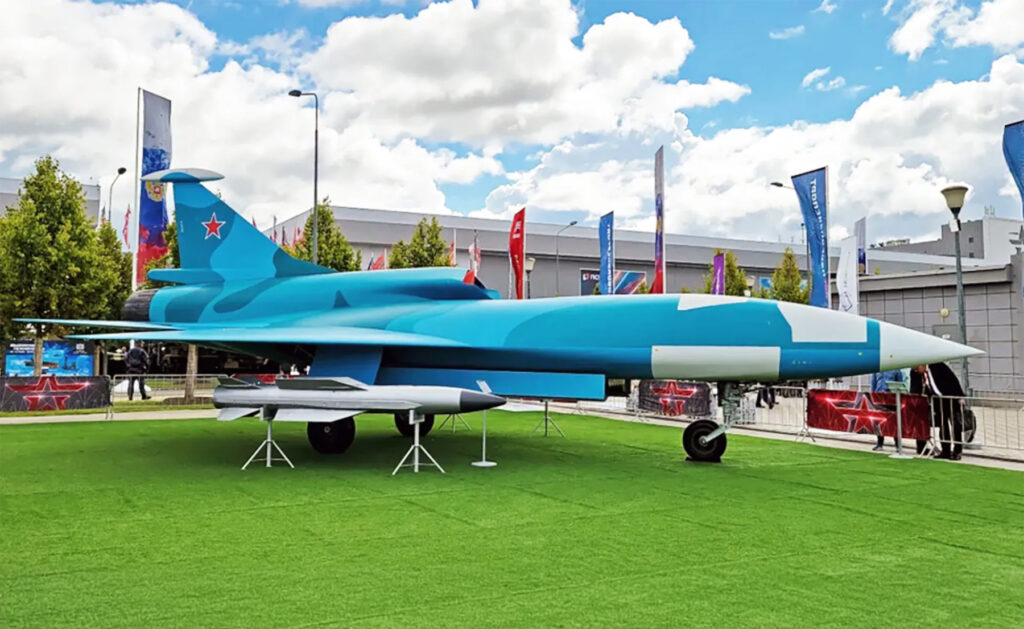
The new design of the Russian Grom drone focuses on speed and manoeuvrability, abandoning stealth to adapt to modern requirements.
The Russian Grom combat drone, originally designed for stealth, has recently been redefined to focus on speed and performance, to the detriment of its stealth capabilities. Presented at the Army 2024 exhibition near Moscow, this new concept marks a turning point in Russia’s approach to combat drones. Powered by a turbojet engine, the Grom can reach a maximum speed of 1,000 km/h, with a payload of 2,000 kg. This change of design could be influenced by the lessons learned from the conflict in Ukraine and technical constraints. However, questions remain about the feasibility of the project and its ability to go into production.
Background and development of the Grom project
The Grom UAV, meaning “Thunder” in Russian, represents one of Russia’s latest initiatives in the field of unmanned combat aerial vehicles (UCAVs). Originally unveiled in 2020, the Grom was designed to operate as a “loyal wingman”, a drone that accompanies manned fighter jets, intended to carry out dangerous and complex missions. However, the original version emphasised stealth, with a design similar to that of other modern drones, such as the Airbus Barracuda or the American XQ-58 Valkyrie.
At the Army 2024 exhibition, a new version of the Grom was presented, featuring a completely different design philosophy. This radical change seems to indicate a reorientation of Russian technological priorities, probably influenced by the lessons learned from the conflict in Ukraine. The new design emphasises speed and manoeuvrability over stealth, moving closer to Cold War-era tactical fighters such as the MiG-21 and Su-22.
Technical characteristics of the new Grom
The new Grom features a truncated delta wing and a conventional rear section with horizontal stabilisers and a vertical fin. It is powered by a turbojet engine, with a trapezoidal air intake located above the rear fuselage. This design is reminiscent of Soviet jet drones of the time, such as the Tu-141 Strizh and Tu-143 Reys, which have recently been repurposed by Ukraine as single-use attack drones.
The technical specifications announced by the manufacturer, Kronshtadt, include a maximum altitude of 12,000 metres and a maximum speed of 1,000 km/h. The drone also has an internal weapons bay, optimised to maintain its aerodynamic characteristics at high speed. It can carry up to 2,000 kg of munitions, including bombs and missiles guided by laser, satellite or television.
By comparison, the American F-16, a light fighter, reaches a maximum speed of 2,414 km/h at high altitude, but with a similar combat payload. The Grom is therefore positioned as a high-performance drone, designed for missions requiring speed and strike capability.

Strategic implications and consequences of the design change
The shift from a stealthy design to one focused on performance and speed is significant. This change can be seen as a direct response to the challenges posed by modern air defences, which are becoming increasingly sophisticated and capable of detecting stealth drones. By opting for a faster, more manoeuvrable drone, Russia could seek to overcome these defences by relying on speed rather than evasion.
The Grom, in its new iteration, could also be used for high-speed reconnaissance missions, rapid strikes in enemy territory or to accompany manned aircraft on complex missions. Its design seems optimised for operations in contested environments, where the drone’s survival depends as much on its ability to avoid enemy fire as on its ability to withstand it.
This change in design could also indicate limitations in Russian industrial capabilities in terms of stealth technologies. Producing stealth drones requires advanced materials and sophisticated manufacturing techniques, which can be difficult to master in a context of international sanctions and economic constraints. The Grom could therefore represent a pragmatic solution, favouring more accessible technologies while meeting immediate operational needs.
Comparison with other similar projects
The Grom is not the only combat drone project under development in Russia. The S-70 Okhotnik-B, another combat drone, was designed to operate in tandem with the Su-57, Russia’s fifth-generation stealth fighter. However, development of the Okhotnik-B has been slow, probably due to technical difficulties and delays caused by the war in Ukraine.
Compared with the S-70, the Grom appears to be a less ambitious but potentially more feasible alternative in the short term. While the Okhotnik-B focuses on stealth and a larger payload, the Grom is positioned as a lighter, faster drone that is cheaper to produce. This diversification of capabilities could enable Russia to respond to different types of threats and missions, depending on operational needs and budgetary constraints.
Future prospects and challenges
The development of the new version of the Grom is still in its early stages, and many questions remain as to its ability to enter production and be deployed in the field. Russia is facing major economic challenges, exacerbated by international sanctions and the high costs of the conflict in Ukraine. Funding for new military programmes, including the Grom, could be limited by these constraints.
What’s more, the Grom’s real effectiveness on the battlefield remains to be demonstrated. Although the design is promising, its ability to compete with similar combat drones developed by other nations, such as the United States or China, will depend on the quality of its manufacture, maintenance and performance in real-life conditions.
The Grom, in its new design, represents an innovative and pragmatic approach on the part of Russia to strengthen its unmanned aerial combat capabilities. However, the success of this programme will depend on the country’s ability to overcome the economic and technical challenges, while developing a UAV capable of meeting the requirements of modern conflicts. The Grom could play a key role in Russian military strategy in the future, but much remains to be proven before it becomes an operational reality.
War Wings Daily is an independant magazine.